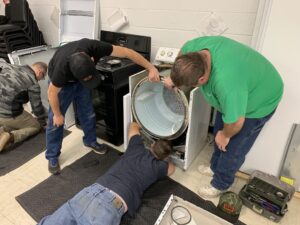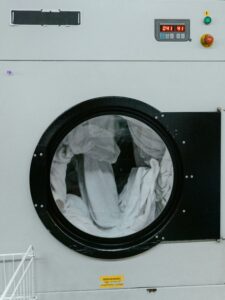Having a functioning dryer is essential in any household or business setting. It allows us to quickly and efficiently dry our clothes, saving us time and effort. However, when a dryer malfunctions, it can be incredibly frustrating and inconvenient. Not only does it disrupt our daily routine, but it can also lead to damp and musty clothes. In this article, we will discuss the importance of regularly checking and maintaining your dryer to prevent malfunctions. We will provide step-by-step instructions on how to troubleshoot common issues that may arise.
Key Takeaways
- Always check the power source before assuming a problem with your appliance.
- Inspect the power cord for any visible damage or wear and tear.
- Look for tripped circuit breakers and reset them if necessary.
- Check the outlet for any signs of damage or malfunction.
- Test the door switch to ensure it is functioning properly.
- Check the control panel for any error codes or malfunctions.
- Inspect the thermal fuse for any signs of damage or overheating.
- Check the motor for any visible damage or malfunction.
- Look for burnt wires or connections and replace them if necessary.
- If all else fails, call a professional for assistance.
Check the Power Source
One of the first things you should do if your dryer is not working is to check the power source. It may seem obvious, but sometimes the dryer may simply be unplugged or not receiving power for some reason. Start by ensuring that the dryer is properly plugged into an outlet. If it is plugged in, check if the outlet is functioning properly by plugging in another device and seeing if it works.
If the outlet is working fine, you can move on to checking the circuit breaker. A tripped circuit breaker can cause the dryer to stop working. Locate your circuit breaker panel and look for any switches that are in the “off” position or not fully in the “on” position. If you find any, switch them off and then back on again to reset them.
Inspect the Power Cord
The power cord of your dryer is responsible for delivering electricity from the outlet to the appliance. Over time, the power cord can become damaged or frayed, which can pose a safety hazard and cause the dryer to malfunction. To inspect the power cord, unplug the dryer from the outlet and visually inspect the entire length of the cord for any signs of damage.
Look for any cuts, frays, or exposed wires. If you notice any damage, it is important to replace the power cord immediately to prevent any potential electrical hazards. You can purchase a new power cord from an appliance store or contact the manufacturer for a replacement.
Look for Tripped Circuit Breakers
As mentioned earlier, a tripped circuit breaker can cause the dryer to stop working. If you have checked the power source and the dryer is properly plugged in, but it still does not turn on, it is worth checking the circuit breakers. Locate your circuit breaker panel, which is usually found in the basement or utility room.
Open the panel and look for any switches that are in the “off” position or not fully in the “on” position. If you find any, switch them off and then back on again to reset them. This should restore power to the dryer. If the circuit breaker continues to trip, it may indicate a larger electrical issue and you should contact a professional electrician for further assistance.
Check the Outlet
In addition to checking the power source and circuit breakers, it is important to ensure that the outlet itself is functioning properly. Over time, outlets can become worn out or damaged, which can prevent them from delivering electricity to your appliances. To check the outlet, unplug the dryer and plug in another device, such as a lamp or phone charger, to see if it works.
If the device does not work, it may indicate that there is an issue with the outlet. In this case, you should contact a professional electrician to inspect and repair the outlet. It is important not to attempt any repairs yourself unless you have experience working with electrical systems.
Test the Door Switch

The door switch is a safety feature that prevents the dryer from running when the door is open. If the door switch is faulty or not functioning properly, it can prevent the dryer from starting or running. To test the door switch, unplug the dryer and locate the switch near the door opening.
Press and release the switch to see if it clicks. If it does not click, it may indicate that the switch is faulty and needs to be replaced. You can purchase a new door switch from an appliance store or contact the manufacturer for a replacement.
Check the Control Panel
The control panel of your dryer allows you to select the desired settings and start the drying cycle. If the control panel is malfunctioning or not responding, it can affect the dryer’s performance. To check the control panel, unplug the dryer and inspect the buttons and display for any signs of damage or wear.
Press each button to see if it responds and check if the display is working properly. If you notice any issues, such as unresponsive buttons or a blank display, it may indicate that there is a problem with the control panel. In this case, you should contact a professional technician to inspect and repair the control panel.
Inspect the Thermal Fuse
The thermal fuse is a safety device that protects the dryer from overheating. If the thermal fuse is blown, it will prevent the dryer from running. To inspect the thermal fuse, unplug the dryer and locate it on the back panel or inside the dryer cabinet.
Use a multimeter to test the continuity of the thermal fuse. If there is no continuity, it means that the thermal fuse is blown and needs to be replaced. You can purchase a new thermal fuse from an appliance store or contact the manufacturer for a replacement.
Check the Motor
The motor of your dryer is responsible for spinning the drum and circulating hot air to dry your clothes. If the motor is faulty or not functioning properly, it can cause the dryer to stop working. To check the motor, unplug the dryer and remove the back panel or access panel.
Visually inspect the motor for any signs of damage or wear. Check if it spins freely and listen for any unusual noises. If you notice any issues, such as a seized motor or grinding noises, it may indicate that there is a problem with the motor. In this case, you should contact a professional technician to inspect and repair the motor.
Look for Burnt Wires or Connections
Burnt wires or connections can cause a dryer to malfunction. Over time, the electrical connections in your dryer can become loose or corroded, which can lead to overheating and burnt wires. To check for burnt wires or connections, unplug the dryer and remove the back panel or access panel.
Visually inspect the wires and connections for any signs of burning, melting, or corrosion. If you notice any issues, it is important to contact a professional technician to inspect and repair the electrical system. Attempting to repair electrical issues yourself can be dangerous and should be left to trained professionals.
Call a Professional for Assistance
If you have followed all of the above steps and your dryer is still not working, it may be time to call a professional for assistance. A professional technician will have the knowledge and experience to diagnose and repair any complex issues with your dryer. They will also have access to specialized tools and replacement parts that may be needed.
When choosing a professional, it is important to find someone who is reputable and reliable. Ask for recommendations from friends or family members, or do some research online to find customer reviews and ratings. It is also a good idea to contact multiple professionals for quotes before making a decision.
Regularly checking and maintaining your dryer is essential to prevent malfunctions and ensure its proper functioning. By following the steps outlined in this article, you can troubleshoot common issues that may arise with your dryer. However, if you are unable to resolve the issue on your own, it is important to seek professional help. Remember, safety should always be your top priority when dealing with electrical appliances.
If you’re dealing with a dishwasher that won’t turn on, it can be frustrating and inconvenient. However, before calling a professional, it’s worth diagnosing and fixing power issues yourself. In a recent article by 911 Appliance Repair, they provide helpful tips and step-by-step instructions on how to troubleshoot power problems with your dishwasher. From checking the power supply to testing the door latch switch, this article covers all the necessary steps to get your dishwasher up and running again. To learn more about diagnosing and fixing power issues with your dishwasher, check out the article here.
FAQs
What are some common reasons why a dishwasher won’t turn on?
Some common reasons why a dishwasher won’t turn on include a tripped circuit breaker, a faulty door latch, a malfunctioning thermal fuse, a broken control panel, or a defective motor.
How can I check if the dishwasher’s circuit breaker has tripped?
To check if the dishwasher’s circuit breaker has tripped, locate the circuit breaker panel in your home and look for the switch labeled “dishwasher.” If the switch is in the “off” position, flip it back to the “on” position. If the switch immediately flips back to the “off” position, there may be an electrical issue that requires professional attention.
What should I do if the dishwasher’s door latch is faulty?
If the dishwasher’s door latch is faulty, it may need to be replaced. To check if the door latch is the issue, inspect it for any visible damage or wear. If it appears to be in good condition, use a multimeter to test its continuity. If the door latch fails the continuity test, it will need to be replaced.
How can I test the dishwasher’s thermal fuse?
To test the dishwasher’s thermal fuse, use a multimeter to test its continuity. If the thermal fuse fails the continuity test, it will need to be replaced. It’s important to note that the thermal fuse is a safety device that is designed to prevent the dishwasher from overheating, so it’s important to address any issues with the thermal fuse promptly.
What should I do if the dishwasher’s control panel is broken?
If the dishwasher’s control panel is broken, it may need to be replaced. To check if the control panel is the issue, inspect it for any visible damage or wear. If it appears to be in good condition, use a multimeter to test its continuity. If the control panel fails the continuity test, it will need to be replaced.
How can I tell if the dishwasher’s motor is defective?
To tell if the dishwasher’s motor is defective, listen for any unusual noises when the dishwasher is turned on. If the motor is making grinding or buzzing sounds, it may be defective and need to be replaced. Additionally, use a multimeter to test the motor’s continuity. If the motor fails the continuity test, it will need to be replaced.



